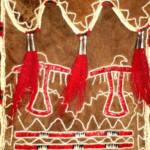Wampum is a familiar name for money. Most people have a general idea that it originated among Native Americans, but the various forms and meanings of the word are little known among most English speakers.
The original form of the word in English was wampumpeag, adapted from Massachuset (an Algonquian language) wampompeag. The word denoted beads of polished tubular shells typically threaded on strings.
The Massachuset word was a combination of three elements: wampan (“white”) plus api (“string”) plus -ag (a plural suffix). Thus the word can be translated as “string of white (shell beads).” English speakers began recording the Massachuset word in the early 17th century because it was at that time that Native Americans began using the beads as money in trade with Europeans, European currency being in short supply.
As indicated by its name, wampumpeag pertained specifically to white beads. However, the Native Americans also used black or dark purple beads, which were more valuable than the white.
An early quotation refers to the difference in value between white and black wampumpeag: “Wampampeag shall pass currant in the payment of Debts, to the payment of forty shillings, the white at eight a penny, the black at four” (1643, Oxford English Dictionary).
But the specific words for “string of black (shell beads)” or “black bead money” never entered English. Many etymologists believe that the tendency to generalize the name of the more common white variety to stand for all bead strings was probably already present among the Native Americans themselves.
Wampumpeag was soon shortened to the synonymous wampum. In fact, the two words are still interchangeable today.
Wampum served three major purposes in Native American culture: money, ornaments, and symbolic communication.
Wampum was exchanged as money between Native Americans, between Native Americans and Europeans, and, in early colonial times, even between Europeans.
Here is an early quotation using the word wampum for money: “Their white (money) they call Wompam (which signifies white), their black suckauhock (sucki signifying black)” (1643, Oxford).
In the following quotation the differences between white and black money beads are outlined more fully: “Their owne [money] is of two sorts: one white, which they make of the stem or stocke of the Periwinkle…and of this sort six of their small Beads…are currant with the English for a peny. The second is black, inclining to blew, which is made of the shell of a fish…and of this sort three make an English peny” (1643, Oxford).
The second major purpose of wampum was to serve as jewelry and ornamental clothing. Besides using the bead strings as necklaces and bracelets, Native Americans wove the beads into belts, sashes, and other garments.
Here is a description of a wampum belt: “These belts are made of shells found on the coasts of New England and Virginia, which are sawed out into beads of an oblong form….Being strung on leather strings, and several of them sewed neatly together…they then compose the same, what is termed a Belt of Wampum” (1778, Oxford).
The third major purpose of wampum was to serve as a symbolic form of communication. Native Americans did not have writing. As a substitute for writing in tribal histories, intertribal messages, treaties, and so on, they arranged their beads into patterns that conveyed messages.
This quotation exemplifies the symbolic use of wampum: “holding in his hands a belt of wampum, or beads, which by their colours and arrangement, form the Indian record for past events” (1823, Oxford).
Today English speakers still use the word wampum as an informal word for money.
______________________
The Oxford English Dictionary. 2nd ed. Oxford, England: Clarendon Press, 1989.



